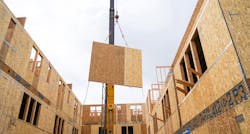The Synergy of Industrialized Construction and Built-for-Rent Housing
In early August, McStain Neighborhoods, in Denver, was considering a 220-unit townhome project for a “major” build-to-rent (B2R) operator. To accelerate production and serve what is arguably the hottest trend in home building right now, the builder brought its off-site manufacturer Simple Homes into the conversation.
McStain’s president, David Ware, isn’t alone in thinking that B2R is a choice market for off-site construction. “With labor and supply chain constraints across the industry, the simplicity and predictability of the build-to-rent business can drive faster adoption of factory-built solutions,” says Dennis Steigerwalt, president of the Housing Innovation Alliance.
RELATED
- Housing, Industrialized: Your Road Map to Off-Site Construction
- Forecasting the Future of Home Construction
- Are You Ready for Build to Rent?
- Off-Site Construction: A Real-World Study
Corey Donahue wholly agrees. The co-founder of Bettr Homes, a Tampa, Fla.-based B2R startup, relies on a 20,000-square-foot factory to produce wall panels for two homes a day. A second, 40,000-square-foot factory in central Florida was poised to come online this summer, and Bettr Homes has a third, 65,000-to-70,000-square-foot factory in the works that most likely will be built in the Atlanta market—all to support ambitious B2R plans.
Donahue’s background includes a stint with the investment firm Blackstone, one of the country’s largest owners of single-family rental properties. In 2017, he co-founded the full-service single-family rental platform Second Avenue Group, but left earlier this year to start Bettr Homes because “the only way you can effect change in this industry is to be a builder,” he says.
Bettr Homes is on track to deliver 309 rental homes in 2021, all in Florida, and Donahue wants his company to be the industry’s largest single-family B2R builder within five years—a goal that will require seven hub factories, each with five smaller satellites, across America.
Bettr Homes would be those plants’ main—but not exclusive—customer. Donahue says that other B2R institutions have already knocked on his door. Long-term, he believes 70% of Bettr Homes’ off-site manufacturing will be for B2R institutions; the rest for individual homeowners.

